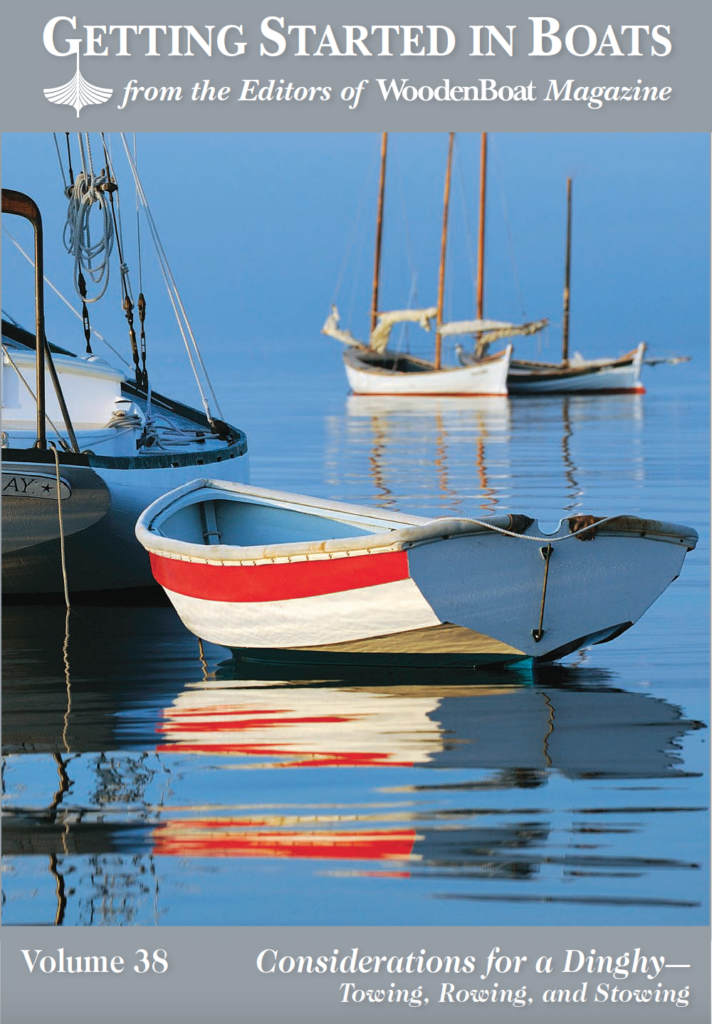Towing, Rowing, and Stowing a Dinghy
Tender, dinghy, dink—call it what you will. The small boat that carries people, gear, and supplies to and from a larger one performs a basic but vital function. That function is so basic, in fact, that these boats are often an afterthought—cobbled-together beaters or toy-like affairs obtained only for their ability to float a load. There are, however, factors other than mere buoyancy to consider when selecting a dinghy. Some careful attention to these factors can turn a potentially mundane or frustrating experience into a rewarding one.
What makes a good dinghy? There’s no single answer, for the ideal varies depending upon the size and type of the mothership, the shoreside situation, and the recreational inclinations of the owners. Will you carry the boat on deck, or tow it? Will you go from a beach or from a dinghy dock? Do you want to spend hours in your dinghy exploring your destination once you arrive?
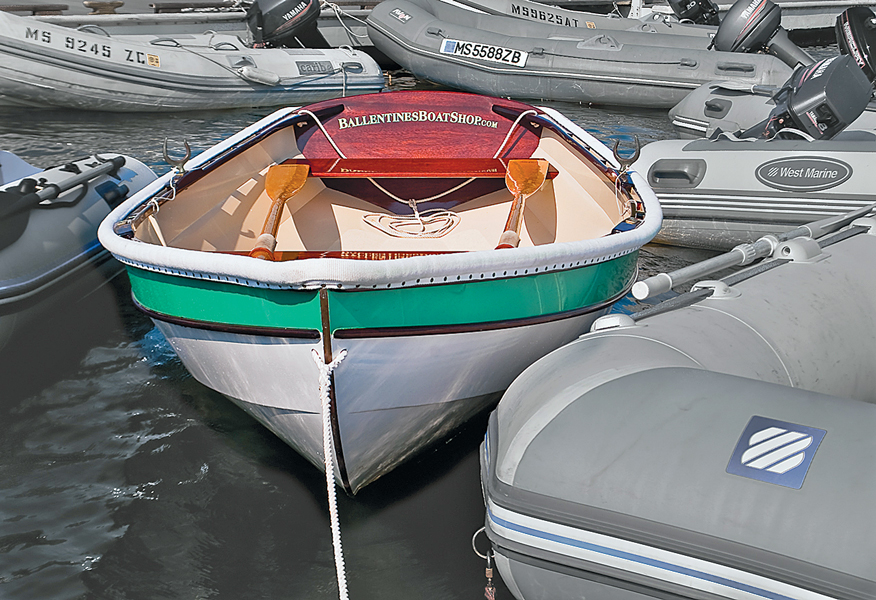
A well designed dinghy, such as this Shellback properly outfitted with rubrail and oar leathers, is a satisfying rowboat with a capacity similar to a standard inflatable. (Boat built by Ballentine’s Boat Shop).
I’ve distilled the basic characteristics of a dinghy into three features which, conveniently, rhyme: rowability, towability, and stowability.
You’ll note that I’ve omitted “motorability.” I’ve done so not just because it doesn’t rhyme with the other three, but because I have a personal bias against outboard-motor-powered dinghies. For general use, I think they’re overrated: They require additional storage for the motor and gasoline; if they’re good motorboats, they probably aren’t good rowboats (more on this shortly); and modestly powered ones travel about as fast as a good rowboat, which I reckon to be about 2–4 knots—close to the speed limit in most anchorages. Plus, I spent a fair amount of time in my youth pulling the starting cord of a 1970s-vintage 3.5-hp Eska motor, burning time and energy that could have been otherwise spent at the oars. Discovering good rowing dinghies was a liberating thing for me, and I hope I can convince you of this, too.
I do acknowledge that for long distances or for people with physical disabilities, a small outboard can be a godsend. So can a sailing rig. But for this basic discussion of the elements of a good dinghy, we’ll deal only with rowboats—good, old-fashioned, rigid rowboats.
What Makes a Good Towing Dinghy?
To understand the characteristics of a good towing dinghy, it’s first helpful to consider what makes a poor one. A badly behaved dinghy under tow will track poorly, will bury its bow in waves, and will drag water behind it. Let’s consider each of these vices, and how to overcome them.
A poor-tracking boat will steer a sinuous path behind the mothership. In snotty conditions and a following sea, it might even turn sideways, roll over, and swamp. What makes for poor tracking? The first culprit is often the lack of an adequate skeg—that long, keel-like protrusion on the bottom, aft. This so called “lateral plane” keeps the after portion of the boat going straight as it follows the lead of a somewhat steerable bow. And what makes the bow steerable? The absence of lateral plane. Thus, we don’t want our dinghy to have a long, straight, deep keel that runs forward to a deep forefoot. This steerable bow will be tugged along by the bow line—called the “painter”—and should generally stay pointed at the stern of the mothership.
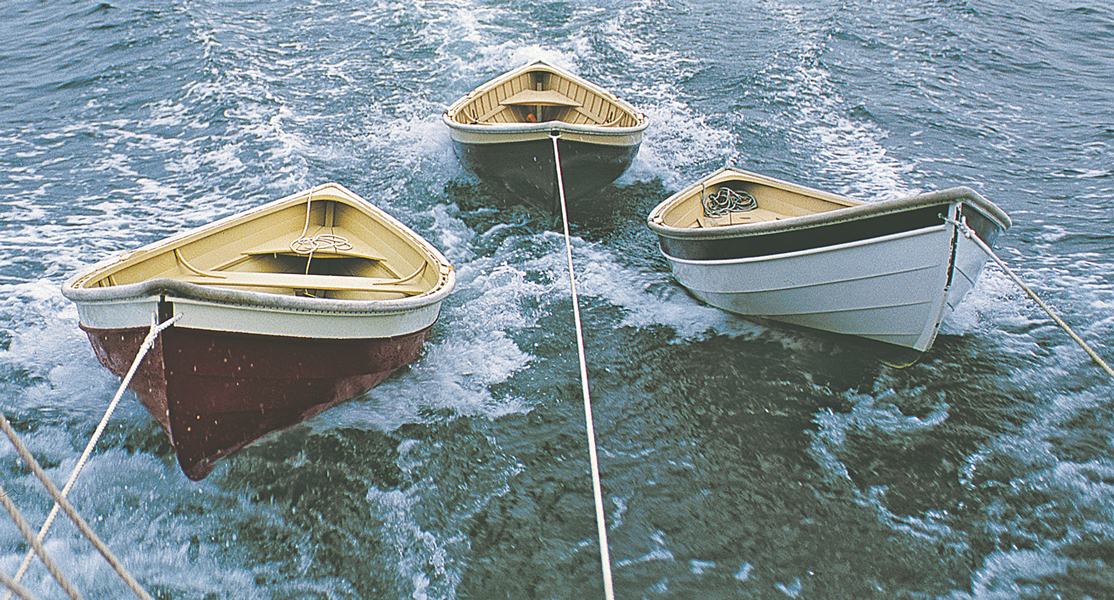
This gaggle of peapods—two plywood Doug Hylan-designed Beach Peas (see A Gallery of Dinghy Designs farther down) flanking a plank-on-frame Jimmy Steele model—display the good towing manners described above.
The dinghy under tow will bury its bow in cases where the bow is too fine or the “chin” of the stem profile too deep in the water. Pram-bowed boats—those with transoms forward as well as aft—will plow up more water than a bow that comes to a point, and even take water aboard if the forward transom is not well clear of the water when the boat is under tow. If the boat has adequate curvature to its keel profile—or “rocker”—then the bow transom will clear the water and the boat under tow will, appropriately, rock back onto its after sections when it’s tugged along by its nose, lifting the bow even higher. The shape I’m describing here is yet another strike against outboard-powered dinghies, which generally work best if they have broad, buoyant sterns and straight runs aft—just the opposite of what makes a boat tow well.
A rugged towing eye is important. Many boats forgo the hardware, and employ a pair of holes drilled through the sheerstrake to accommodate a line passed through them and encircling the stem. That’s a good way to go and requires no hardware. Although having the towline attached down low on the stem helps lift the bow for improved tracking, this isn’t usually necessary. The motion of the boat through the water should be enough to lift the bow.
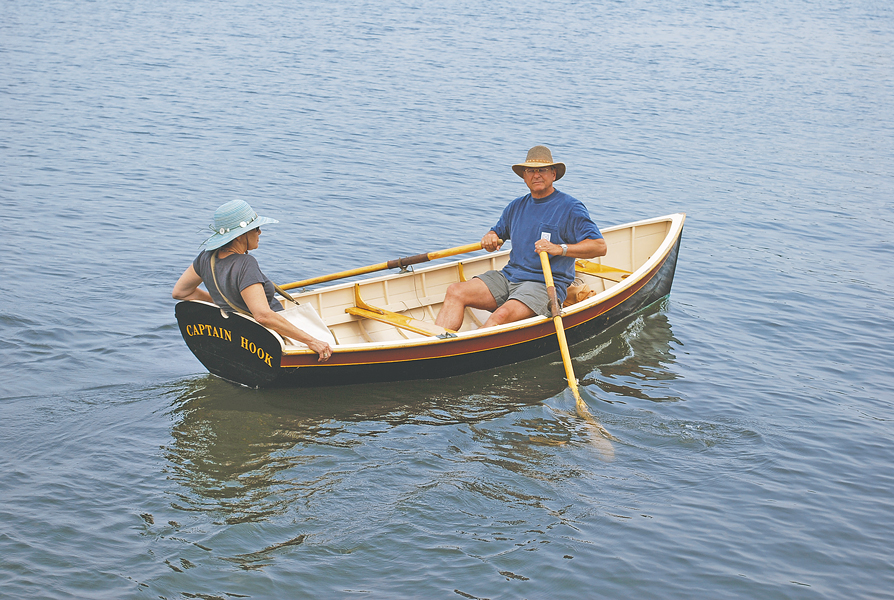
A good rowing dinghy is easy under oars and stable.
What Makes a Good Rowing Dinghy?
The first consideration for a good rowing dinghy is its geometry. Do your hands hit your knees on the recovery portion of your stroke, when your blades are out of the water and moving forward to get another bite of it? If so, that’s poor geometry: Your seat is too high or your oarlocks too low.
Corollary to the geometry question is oar length and style. All oars are not created equal; in fact, most mass-produced, store-bought oars have chunky, untapered looms (shafts), and clunky, unrefined blades. They’ll turn you off from rowing almost as quickly as will rowing an inflatable (see below). Do your hands cross when you pull on the oars? Although that’s typical of competitive rowing craft, it’s overkill and awkward for a simple dinghy. Make sure you choose oars of the appropriate length.
Proper fore-and-aft trim is also very important to good rowing. The boat’s designed waterline should remain more or less level—even if its painted waterline is submerged by the weight of a load of gear and passengers. To remain level in various loading configurations, a dinghy usually requires two rowing stations: a ’midship station for a rower carrying either no passengers or two passengers, one forward and one aft; and a forward station for a rower who’s carrying a passenger in the stern.
Perhaps the best way to understand what makes a good rowing boat is to consider a famously poor-performing rower: the ubiquitous inflatable, the most fashionable dinghy today. Visit almost any yacht club, marina, or municipal waterfront, and chances are that most of the tenders will be inflatables—some with rigid bottoms, some not. Why is this? I credit the wildlife documentaries of the 1970s and ’80s, in which teams of cetacean researchers would observe whales from inflatable Avon boats. Indeed, for a brief time, before a host of other companies began manufacturing these craft, they were often simply called “Avons.”
Inflatable dinghies have good qualities, but these, I believe, are often outweighed by negative qualities that make them poor tenders: They all have pitiful “oars” made of aluminum tubing and plastic blades; they have a flat, shallow bottoms and no skegs to keep them tracking straight, so in a crosswind they’d just as quickly blow sideways as row forward; and they have broad wooden transoms that tend to be immersed when the boat is under tow, and so they tend to drag the harbor along with them. They will move forward when you pull on the oars, but when you stop pulling, they stop. A good rowboat will continue gliding, or will “carry.” Outboard power is really the only option for moving an inflatable, and you already know how I feel about that. Maneuvering an inflatable in close quarters is almost always just an approximation of a good boat handling—especially if there’s a crosswind.
This isn’t a polemic against inflatables. In fact, I’ve been rather smitten with some of the larger, faster rigid-bottom inflatables I’ve seen. To their credit, the dinghy-style inflatables do have some good qualities: They are self-fendering, so your topsides are safe from poor landings—a good thing, because that’s about the only type of landing you can make with them; they can be deflated and then rolled up and stowed in a locker for offshore voyaging; and they are extremely buoyant.
There are three other seemingly contradictory requirements for a good rowing dinghy: bow and stern sections that are relatively fine below the waterline and full above it; a bottom profile that rises aft so the transom clears the water; and broad, firm sections for stability. You can have all of these things, as we’ll see in the gallery of good designs later in this article.
Not All Boats That Row Well Make Good Dinghies
One other observation about rowability: There are many boats that row well but don’t make good dinghies. Consider that icon of the Wooden Boat Revival, the Whitehall pulling boat. Historically, they were meant to go fast and straight under oars. But an authentic one has a long, straight keel and a deeply immersed forefoot, or chin, and this makes it a bear to turn in tight quarters as well as dicey for towing. Likewise, a long, narrow recreational wherry is a joy to row, but not much of a boat for carrying gear and passengers.
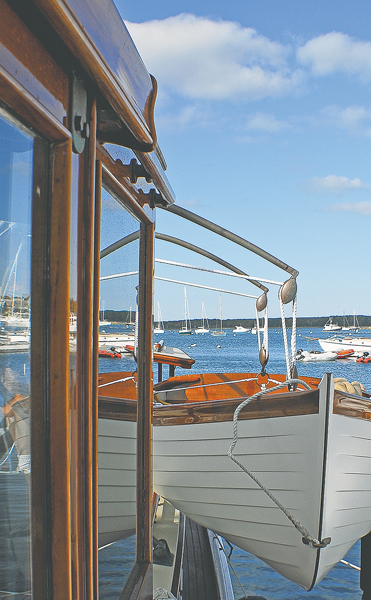
If the size and style of the boat allow them, davits are an excellent means of carrying a dinghy aboard a larger boat.
What Makes a Good Stowing Dinghy?
By stowability, I mean both on the mothership and on shore. If your expeditions begin or end from a beach, is your dinghy light enough to be carried above the high-water mark by your crew—or can it be easily loaded onto a cart? Or, does it have a wheel built into it, so it functions like a wheelbarrow once beached? Is it built to resist drying out during long stretches on deck, as are the glued-lap plywood models such as the Nutshell and the Shellback?
If you’re going offshore, you shouldn’t tow your dinghy: Average bluewater conditions will likely swamp it, and you’ll then have no choice but to abandon it. That’s why offshore cruisers carry their dinghies on deck.
Can you easily get your dinghy aboard and upside down on deck, if that’s how you’re going to carry it? Larger boats have davits—hoisting apparatus for their tenders—located either on the stern or at the rail amidships. On smaller boats without davits, a halyard can come in handy for the lifting portion of the operation.
Once the boat is aboard, is there space on deck to stow it? Do you have chocks built into your deck to keep the dinghy secure, and to serve as lashing points? Some dinghies are built to be broken apart into two pieces—a forward one and an after one—that can be “nested” together as a single unit for stowing. Early versions of nesting dinghies were a compromise on performance, but some recent examples— one of which is shown below—have all but eliminated the compromise: You can now have your nice dinghy, and nest it, too.
A Gallery of Dinghy Designs
A Wheelbarrow Boat
Harry Bryan designed this wheelbarrow boat in two sizes (6′ and 7′) as an easily beachlaunched tender. While her wheel adds a bit of drag when under tow, this is minimal, as the wheel turns as water flows over it.
The boat will carry two average-sized people in calm waters and one in a chop; thus, a larger dinghy tied astern of the mothership might be required in some cases, to return to the beach to pick up the coolers and cousins. The oars slide through holes in the transom to become the wheel barrow’s handles. Ladybug’s rails are closer to the water than other dinghies such as the Nutshell Pram (below), and her seats are lower accordingly. She’s not meant to carry much of a load of gear or people, or to sail, but when there’s a long carry down the beach, the Ladybug is a great friend.
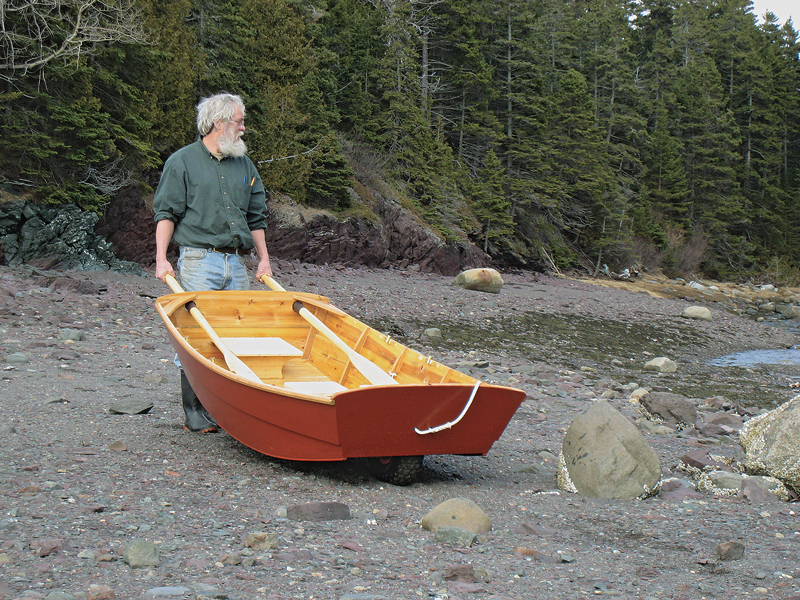
Ladybug Pram makes easy work of getting off the beach (plans and finished boats from Bryan Boatbuilding).
A Good All-around Dinghy
Joel White designed the Nutshell Pram in the early 1980s in two sizes, 7′ 7″ and 9′ 6″. Both boats have become quite popular as tenders, for they have wide ’midship sections that allow them to carry a load, and they have fine underwater sections forward and aft for good towing and rowing. There’s ample buoyancy above the waterline to keep them from settling too deep in the water as they’re loaded down.
At first glance, they may appear to be simple prambowed boats, but one of the secrets to their good manners is that they have a partial stem at waterline level, giving them a sharp but shallow entry. Rather than carry this stem out to a pointed bow, White truncated the boat with a forward transom to give it a manageable overall length. An optional rig expands the boat’s range for exploration and recreation in port. The photo showing the yellow boat on deck is of Jack Bassett’s 25′ Vertue cutter (see page 72 of WoodenBoat Jan/Feb 2013 | Issue 230). This Nutshell has been carried from Maine to the Azores and back.

The Nutshell Pram, under sail (right) and on the deck of the Vertue cutter FLYING FISH approaching the Azores (purchase plans for the Nutshell from The WoodenBoat Store).
Different Boats for Different Situations
Beach Pea
Doug Hylan’s Beach Pea is based on the working peapods of the Maine coast. But, built of glued lapstrake plywood, it’s much lighter than the carvel-planked originals, so is easily hauled above the high tide mark by two people.
With its relatively broad ’midship section and firm bilges, the boat carries a load of gear or people. Because of its fine ends, it tows and rows beautifully; in fact, it needs no skeg to track straight, because its fine stern settles into the water a bit under tow, and a straight keel aids its tracking. It has only one rowing station; with a passenger on board, the rower simply reverses direction, so the bow effectively becomes the stern. The boat’s size, however, precludes it from being carried aboard most boats. This boat is available from various builders, including designer Doug Hylan.
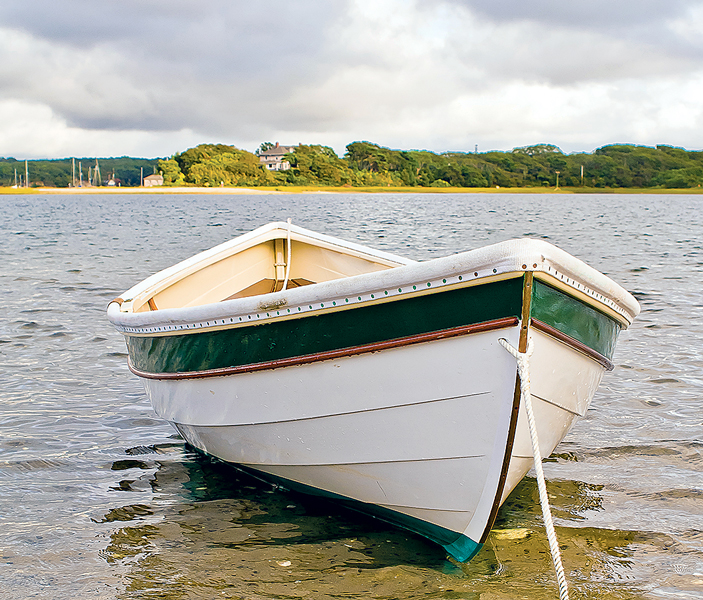
While too large to carry aboard most cruising boats, Beach Pea has excellent towing characteristics and can heft a load of gear and people (built by Ballentine’s Boat Shop; plans and finished boats from D.N. Hylan & Associates).
The PT 11
This 11′-long dinghy designed by Russell Brown divides into two pieces to form a bundle measuring only 5′10″ in length, 4′ 2″ wide, and 1′ 8″ high—an easily stowed package on the decks of most cruising boats. The boat reportedly rows very well, accelerating quickly, tracking straight, and having good rowing geometry. Sophisticated hardware allows for precise and secure alignment of the halves—an operation that can be conducted when the boat is afloat. She’s been subjected to rigorous towing tests, too—some at high speed—and has proven to be a good follower behind the mothership.
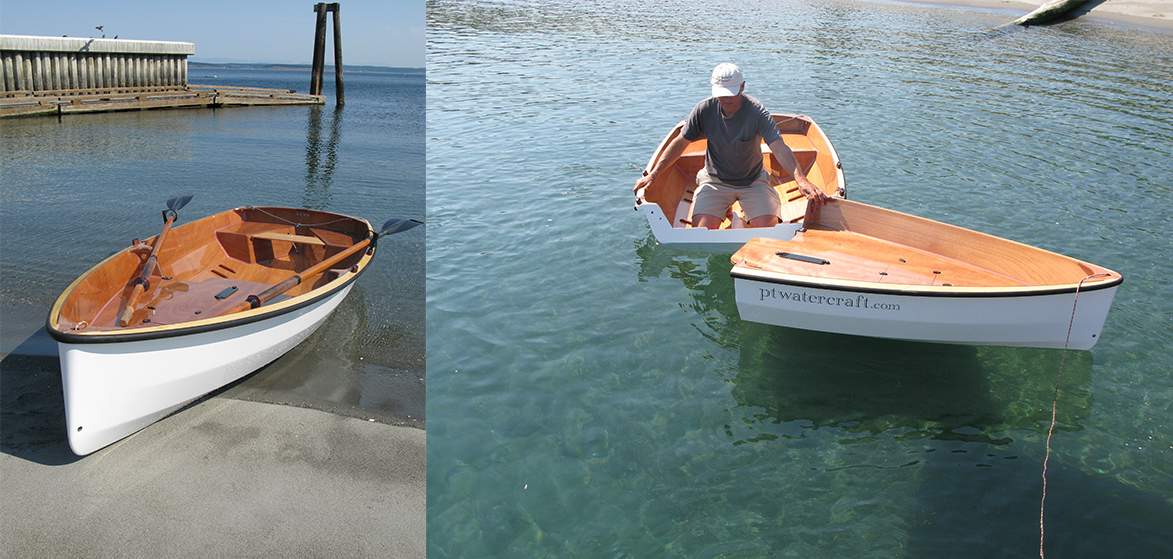
The PT 11 is both a tender and an exciting daysailer that can be reduced to a small bundle for stowing (kits available from PT Watercraft).
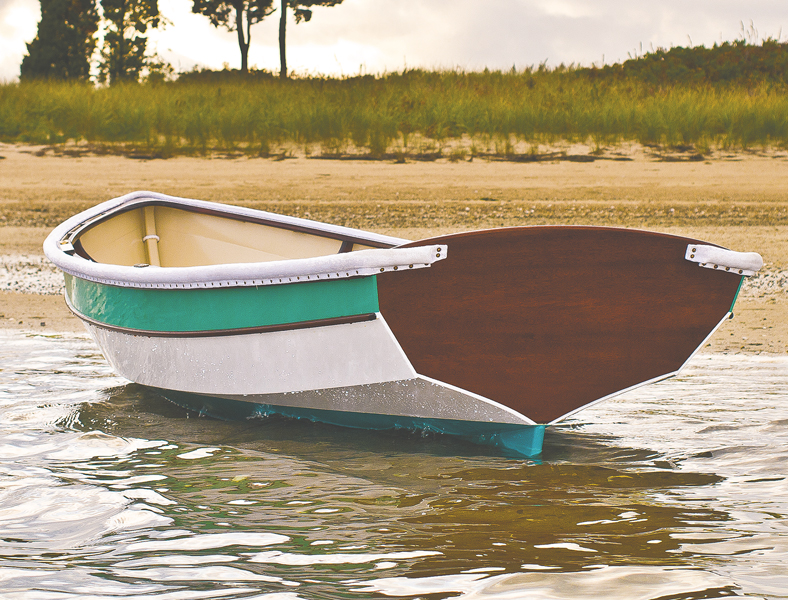
This Joel White-designed Shellback dinghy has a nicely fitted and fastened rubrail on its gunwale; the boat will be a good neighbor at the dinghy dock, and will be kind to the topsides of the mothership. (Plans for the Shellback, which is also featured on the cover of this edition of Getting Started in Boats, are available from The WoodenBoat Store).
Protecting Your Investment
Gunwale Guard, Bow Pudding, and Oar Leathers
If your own boat, or any of those you’ll be visiting, has nicely finished topsides, then you need gunwale guard. This stuff is essentially a long rod of dense foam rubber covered in canvas or heavy synthetic cloth. A pie-shaped quarter of the section of the tube is cut away along its length, so the gunwale guard may be fitted to the top outboard corner of a dinghy’s gunwale and fastened.
A little extra padding is sometimes required at the bow. You can get fancy and make a nice rope bow pudding (see WoodenBoat No.109), or you can tack the heel of a non-marking rubber-soled boot (an L.L. Bean duck hunting boot is the standard for this) on your stemhead.
Finally, if you have a nice set of oars, they’ll need a nice set of leathers to keep them from getting chewed up by your oarlocks. They should be stitched in place, and not tacked. Watch our video on Leathering Oars, or follow these instructions on stitching a set of oar leathers from WoodenBoat.
Matthew P. Murphy is editor of WoodenBoat.

